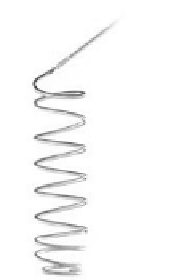Biomedical Engineering Reference
In-Depth Information
2.1.3.2 Cerebral aneurysm embolization
From the development of electrically deployable coil in 1991 by
Gugliemi
et al.
, the cerebral aneurysm embolization technique rapidly
spread worldwide [2]. In conventional mechanically detachable
coils, immediately after the detachable section of a coil leaves the
micro-catheter used for the medical treatment, a mechanical lock
is released and separates it from the micro-catheter. On the other
hand, for electronically deployable coils, the detachment will not
happen immediately after the detachable section leaves the catheter
but will be safely released after it has been veriied that the coil
is installed in the target location. In those days, coils were made
from platinum with helical shape (Fig. 2.3a) and three-dimensional
shapes. A large number coil types were commercialized by different
companies; for example, coil varieties with surface polymer coating
may have characteristics such as enlarging its volume with moisture
absorption or promotion of tissue organization (Fig. 2.3c) (by
Boston Scientiic Japan Co.). The development of DSA made possible
to register 3D data accompanied with the development of rotational
DSA, and lat panels were big progress for improving the medical
treatments quality.
a)
b)
c)
Figure 2.3
Coils (by Boston Scientiic Japan Co.) (a) Helical type is
the most common use type. (b) 3-D shape coils (c) Coil
with macromolecule polymer coating for promoting tissue
organization.
2.1.3.2.1 Medical treatments
Figure 2.4 shows a system for aneurysm embolization. The white
arrow points at guiding catheter, the black one at a micro-catheter



















































Search WWH ::

Custom Search